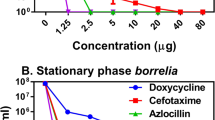Summary
Spirochaetal infections have been successfully treated with penicillin; more recently, erythromycin has been used in cases with known penicillin allergy. The discovery of the spirochaeteBorrelia burgdorferi and the elaboration of a new generation of macrolides with properties that differ from older macrolides have led to new ways of treating spirochaetal disease with these compounds. This paper presents data on thein vitro andin vivo efficacy of a combination of roxithromycin and co-trimoxazole againstB. burgdorferi. In vitro (checkerboard technique;B. burgdorferi strain B31; modified BSK II medium) it was found that while roxithromycin showed excellent efficacy againstB. burgdoferi (MIC 0.031 mg/l), co-trimoxazole had no effect. However, the combination of both chemotherapeutics led to a minor synergistic effect, decreasing the MIC for roxithromycin by one dilution step at concentrations of co-trimoxazole from 256 to 8 mg/l. In addition, a clearly reduced growth of microorganisms was seen at concentrations of roxithromycin as low as 0.015 mg/l in combination with 256 to 4 mg/l co-trimoxazole, when compared to the positive controls. Most interestingly, however, the motility ofB. burgdorferi was markedly reduced even when the two drugs were combined at very low concentrations. In anin vivo, non-randomised, open, prospective pilot study it was found that of 17 patients, with confirmed late Lyme borreliosis (stage II/III), treated with combined roxithromycin (300 mg b.i.d.) and co-trimoxazole for 5 weeks, 13 (76%) recovered completely by the end of treatment, and four continued to have symptoms on follow-up at 6 and 12 months. This success rate is similar to that seen with i.v. penicillin and ceftriaxone. It appears that the reduced motility ofB. burgdorferi makes the pathogen mor accessibile to the immune system.
Zusammenfassung
Es wird über diein vitro- undin vivo- Wirksamkeit einer Kombination von Roxithromycin und Co-trimoxazol gegenBorrelia burgdorferi berichtet.In vitro zeigte sich, daß Roxithromycin über eine ausgezeichnete Wirksamkeit gegenüberB. burgdorferi verfügt, Co-trimoxazol war jedoch unwirksam. Die Kombination beider Chemotherapeutika führt zu einem geringen synergistischen Effekt u.z., um eine Verdünnungsstufe bei einer Co-trimoxazol-Konzentration von 256/8mg/1. Bei einer 0.015 mg/l Roxithromycin-Konzentration in Kombination mit 256/4 mg/l zeigte sich in Vergleich zu positiven Kontrollen ein eindeutig reduziertes Wachstum der Mikroorganismen. Die Motilität war sogar eindeutig reduziert, wenn beide Substanzen nur sehr niedrige Konzentrationen aufwiesen. Bei einer offenen prospektiven Pilot-Studie, bei 17 Patienten mit einer gesicherten Borreliose in Stadium II/III, die mit einer Kombination von Roxithromycin (300 mg b.i.d.) 5 Wochen behandelt wurden, waren danach 13 ausgeheilt, vier hatten weiterhin Symptome nach 6 bis 12 Monaten. Das Ergebnis entspricht der einer i.v. Penizillin-oder Ceftriaxon-Behandlung.
Similar content being viewed by others
References
Kirst, H. A., Sides, G. D.: New directions for macrolide antibotics: pharmacokinetics and clinical efficacy. Antimicrob. Agents Chemother. 33 (1989) 1419–1442.
Johnson, R. C., Kodner, C., Russel, M., Girard, D.:In vitro andin vivo susceptibility ofBorrelia burgdorferi to azithromycin. J. Antimicrob. Chemother. 25 (Suppl. A) (1990) 33–38.
Sigal, L. H.: Current recommendations for the treatment of Lyme disease. Drugs 43 (1992) 683–699.
Gasser, R., Reisinger, E., Feigl, B., Pougratz, S., Grisold, M., Klein, W.: Current views on antimicrobial treatment of Lyme disease. Consent of the 5th International Conference on Lyme Borreliosis.
Hansen, K., Hovmark, A., Lebech, A. M., Lebech, K., Olsson, I., Sorensen, L.: Roxithromycin in Lyme borreliosis: discrepant results of anin-vitro andin-vivo animal susceptibility study and a clinical trial in patients with erythema migrans. Acta Derm. Venerol. 72 (1992) 297–300.
Gasser, R., Dusleag, J.: Oral treatment of Lyme borreliosis with roxithromycin plus co-trimoxazole. Lancet 336 (1990) 1189–1190.
Pedersen, L. M., Friis-Møller, A.: Late treatment of chronic Lyme arthritis. Lancet 337 (1991) 241.
Bózsik, B. P., Timmer, M., Esztro, K.: Combined antibiotic treatment of Lyme borreliosis. 5th International Conference on Lyme Borreliosis, Arlington, 1992, abstr. A12 (1992) 67.
Fruhwald, F. M., Gasser, R., Dusleag, J., Feigl, B., Pongratz, S., Klein, W.: Reversal of dilated cardiomyopathy by long-term oral roxithromycin in a patient with late Lyme-borreliosis. International Journal of Angiology 1 (1994) 85–86.
Gasser, R., Dusleag, J., Reisinger, E., Stauber, R., Grisold, M., Pongratz, S., Furian, C., Feigl, B., Klein, W.: A most unusual case of a whole family suffering from late Lyme borreliosis for over 20 years. Angiology 3 (1994) 126–127.
Gasser, R., Dusleag, J., Klein, W.: Oral treatment of early and late Lyme borreliosis. Lyme Disease Update 6 (1992) 1–3.
Dattwyler, R. J., Halperin, J. J., Volkman, D. J., Luft, B. J.: Treatment of late Lyme borreliosis-randomized comparison of ceftriaxone and penicillin. Lancet i (1988) 1191–1194.
Sadziene, A., Thomas, D. D., Bundoc, V. G., Holt, S. C., Barbour, A. G.: A flagella-less mutant ofB. burgdorferi (B.b.) Structural, molecular andin vitro functional characterization. J. Clin. Invest. 99 (1991) 82–92.
Ma, Y., Sturnock, A., Weis, J. J.: Intracellular location ofB. burgdorferi (B.b.) within human endothelial cells. Infect. Immun. 59 (1991) 671–678.
Alder, J., Mitten, M., Hernandez, L., Clement, J.: Synergy between clarithromycin and sulfomethoxazole in the treatment ofPneumocystis carinii in rats. The First International Conference on the Macrolides, Azalides and Streptogramins. Santa Fe, New Mexico, USA, 1992, abstr. 40 (1992).
Labro, M. T., El Benna, J., Barre, J.: Effect of roxithromycin and erythromycin on human neutrophil functionin vivo. The First International Conference on the Macrolides, Azalides and Streptogramins. Santa Fe, New Mexico, USA, 1992, abstr. 39 (1992).
Author information
Authors and Affiliations
Rights and permissions
About this article
Cite this article
Gasser, R., Wendelin, I., Reisinger, E. et al. Roxithromycin in the treatment of lyme disease-update and perspectives. Infection 23 (Suppl 1), S39–S43 (1995). https://doi.org/10.1007/BF02464959
Issue Date:
DOI: https://doi.org/10.1007/BF02464959




